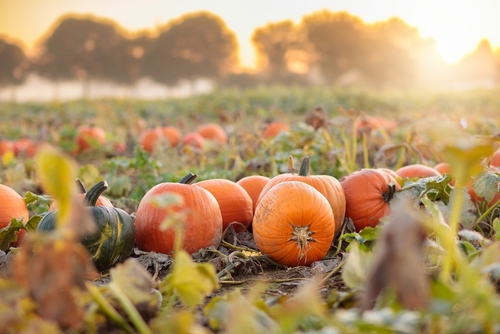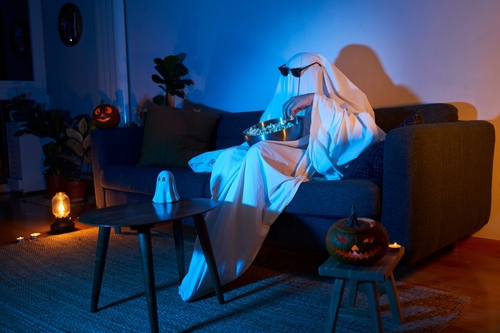Fall has a way of wrapping you up in comfort. The air feels crisp, the trees put on their golden show, and suddenly warm drinks and cozy sweaters become part of the daily routine. For families, this season is an invitation to slow down, make memories, and create rituals that bring everyone closer together.
If you’ve recently moved to the US, starting seasonal traditions can be especially meaningful. They’re a way to make new places feel like home, while still blending in the cultural traditions you carry with you. At Remitly, we know how important it is to feel grounded when you’re far from where you started. That’s why we’ve pulled together some heartwarming fall traditions to help you create the kind of moments that everyone looks forward to year after year.
Outdoor fall adventures
There’s something magical about being outside in autumn. The cooler air, the crunch of leaves underfoot, and the chance to pause and notice the season changing. It makes this time of year perfect for family adventures.
Go apple picking in your coziest sweater

Apple picking is one of those traditions that feels straight out of a storybook. Wandering through rows of apple trees with a basket in hand, sipping warm cider, and watching kids dash from branch to branch makes for the kind of day you’ll want to repeat every year.
Many orchards also offer hayrides, corn mazes, or petting zoos, which makes it an outing with plenty to do. And you can bring the fun home with you. Baking an apple pie, making homemade applesauce, or even trying your hand at cider pressing keeps the tradition going long after you’ve left the orchard.
Hunt for the perfect pumpkin

Pumpkin patches are pure fall magic. Kids love the hunt, sometimes for the biggest pumpkin, sometimes for the tiniest, sometimes for the most wonderfully odd-shaped one.
Once you’ve brought them home, the fun continues. Families often host carving contests, or for those with little ones you can break out the paints or stickers for a safer alternative. Nothing says fall like a row of glowing jack-o’-lanterns on the porch. And when the season’s over, you can roast the seeds for a snack or compost the pumpkins to make your tradition eco-friendly too.
Collect leaves on golden-hour walks

Taking a walk in autumn feels different. The light is softer, the air is cooler, and the leaves practically beg to be scooped up and admired. Making leaf walks a weekly ritual turns something simple into something special.
You might bring a few home to press into a scrapbook, create art projects, or just admire on the kitchen table. Kids love spotting unusual shapes or brilliant colors, and trying to match them to tree types adds a little discovery to your outing. It’s the kind of slow, mindful activity that makes fall feel like fall.
Join local fall festivals and fairs

Fall isn’t only about what you do at home; it’s also about celebrating with your local community. Across the US, towns and cities host harvest festivals, Oktoberfests, and cultural fairs filled with live music, craft stalls, and plenty of seasonal treats.
For families who are new to the area, these gatherings are a wonderful way to feel part of the local rhythm. They also tend to be affordable or free, which makes them easy to add to your yearly calendar. Over time, “going to the fall festival” can become one of your family’s signature traditions.
Take a short fall trip

Sometimes the best way to enjoy the season is to go exploring. Many families add a short getaway to their fall calendar, whether it’s a day trip to a pumpkin festival in a nearby town, a scenic drive through the countryside, or even a weekend in a cozy cabin.
Trips don’t need to be expensive or far away to feel special. Packing a picnic and driving out to see the foliage can be just as memorable as a longer vacation. If you return to the same place each year, it can quickly turn into one of those traditions everyone eagerly anticipates.
Cozy home traditions
When the evenings get darker earlier, there’s no better place to be than home. Fall is made for cozy nights in, and the right traditions can turn your living room into the heart of the season.
Host a fall movie marathon

There’s something undeniably comforting about snuggling under blankets with a big bowl of popcorn and a seasonal movie on screen. Some families love the classics Dead Poets Society and You’ve Got Mail, while others gravitate toward Halloween-themed favorites like Hocus Pocus or Harry Potter.
Letting each family member take turns choosing the movie keeps everyone invested. And if you want to go all in, you can make it a pajama night with hot chocolate or apple cider in hand.
Tell stories and play games together

Not every cozy night has to revolve around screens. Storytelling is another tradition families love to revisit each fall. Some take turns telling ghost stories by candlelight, while others reminisce with funny family memories.
Pairing storytelling with board games or card games makes the evening interactive, giving everyone a break from phones. It’s a low-key tradition that brings out creativity and connection while keeping the atmosphere lighthearted and fun.
Get crafty with fall décor

Decorating for this time of year doesn’t have to mean store-bought garlands or elaborate displays. Some of the best fall decorations are the ones you make together. A pinecone wreath on the door, an acorn garland on the mantel, or hand-painted pumpkins on the porch can transform your home into a cozy autumn retreat.
The best part is that homemade decorations often become keepsakes. Packing them away at the end of the season means you’ll rediscover them year after year, adding layers of memory to your celebrations.
Savoring fall flavors together
Every season has its flavors, but fall’s are especially comforting. Sharing seasonal foods and drinks as a family can be one of those cozy moments you’ll look forward to every year.
Make comfort food part of your fall rhythm

Cooler weather practically begs for comfort food, and fall is the perfect excuse to bring hearty dishes to the table. For some families, that might mean big pots of chili on Sundays, while others might try roasting butternut squash or experimenting with soups and stews.
If you’ve moved from another country, blending your traditional dishes with fall ingredients is a beautiful way to make the season feel uniquely yours. Imagine adding pumpkin to a family curry, or using apples in a dish that reminds you of home; it’s a way to stay connected to your roots while embracing what’s new.
Warm drinks that become rituals

Pumpkin spice lattes may have become a cultural icon, but they’re just the start. Your family could start its own drink tradition, like brewing spiced apple cider, making hot chocolate with toppings, or enjoying pots of tea flavored with cinnamon and cloves.
Bake your way into fall memories

If fall could be bottled up as a scent, it would probably smell like cinnamon, nutmeg, and pumpkin. Baking together not only fills your home with those smells but also gives everyone a role in creating something delicious. Little kids can stir, sprinkle sugar, or shape dough, while older kids might help with measuring or mixing.
Recipes like pumpkin bread, apple crisp, or cinnamon cookies are approachable and always a hit. Over time, your family may even create its own signature recipes that you bring out every autumn.
Heart and home connections
Fall isn’t just about the cozy and the fun; it’s also about reflection, gratitude, and connection. These traditions add depth to the season, reminding us to give thanks and give back.
Grow a family gratitude tree

A gratitude tree is a simple yet powerful way to reflect on the good in your life. All you need is a branch in a vase or a wall display where everyone can add paper leaves. Each day or week, family members write down something they’re thankful for, from big milestones to small joys.
Younger kids can draw pictures instead. By the end of the season, the tree becomes a colorful reminder of everything your family has appreciated. It’s a tradition that fits beautifully alongside Thanksgiving, but is meaningful all on its own.
Volunteer together as a family

While fall is often associated with abundance, it’s also a good time to remember that not everyone has the same comforts. Volunteering together as a family can turn compassion into a tradition.
Food banks, shelters, and schools often need extra help as the holidays approach, and even small contributions, like donating canned goods, can have a big impact. Kids see firsthand what it means to care for others, and the experience becomes a yearly ritual that deepens your family’s sense of gratitude.
Blend cultural traditions with fall

For immigrant families, fall is a chance to create something uniquely yours. Maybe that means blending American customs like pumpkin carving with holidays from your heritage, such as Diwali, Día de los Muertos, or the Mid-Autumn Festival.
You might bring the flavors of home into fall dishes, think pumpkin curry, apple empanadas, or spiced teas, or create a gratitude tree with notes written in more than one language. These combinations don’t just honor where you come from; they give your children a way to celebrate both their roots and their new home.
Making memories last
Traditions don’t have to be big to be meaningful. Sometimes it’s the smallest rituals, like pressing leaves into a scrapbook or taking a yearly photo at the pumpkin patch, that stick the longest.
Whether you try one new tradition this year or embrace several, what matters most is the time spent together. Documenting these moments helps them live on, whether through photos, journals, or recipe cards passed down over the years. Over time, the story of your family’s fall traditions becomes something that grows right alongside your children.
FAQ
How do I start a new fall tradition with my family?
Start small. Pick one activity that feels doable, like apple picking or making a gratitude jar, and repeat it consistently. Over time, it naturally becomes a tradition.
What are inexpensive fall activities for families?
Some of the best fall traditions are completely free. Nature walks, leaf collecting, and decorating with things you find outdoors all create special memories without costing anything. Cozy movie nights at home are another free favorite.
How can I blend my cultural traditions with American fall traditions?
Think of it as layering. You might add your favorite cultural foods to a Thanksgiving table, celebrate a heritage holiday alongside Halloween, or write gratitude notes in two languages.
What fall activities are best for families with toddlers versus teens?
Toddlers usually love simple activities they can touch and explore, like painting pumpkins, collecting leaves, or stirring cookie batter. Teens often enjoy more responsibility and creativity, such as leading the carving contest, volunteering, or curating the family movie playlist.
How do I make sure fall traditions last year after year?
Consistency is key. Repeat the activities that bring the most joy, and find simple ways to record them, whether it’s photos, recipe cards, or journals. The more you revisit them, the more they’ll become a natural part of your family’s rhythm.
